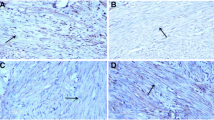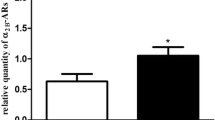Abstract
Introduction
In the pregnant uterus oxytocin and the oxytocin receptor play a major part for uterine contractility and the induction of labor. Clinical evidence implicates that with regard to contractility associated disorders like for example dysmenorrhea also in the nonpregnant and very early pregnant myometrium oxytocin and the oxytocin receptor seem to be more important than believed at the moment. However, little is known about the mutual dependence of the oxytocin receptor, oxytocin and 17-β-estradiol in the nonpregnant myometrium and about the distribution of the oxytocin receptor in the nonpregnant uterus. Therefore, in the present study we investigated in the nonpregnant myometrium if oxytocin receptor expression can be affected by 17-β-estradiol and oxytocin stimulation.
Methods
We used a previously established experimental perfusion system for the human uterus. We perfused 10 uteri for 27 h under physiological conditions without 17-β-estradiol (group A, n=5) or with high 17-β-estradiol stimulation (group B, n=5) followed by oxytocin stimulation in both groups in the last 3 h of the experiment. The expression of the myometrial oxytocin receptor in both groups was compared immunohistochemically.
Results
In comparison to the negative controls the immunohistochemical reactivity demonstrated increasing oxytocin receptor concentrations with maximum levels under 17-β-estradiol and oxytocin stimulation in the uterine fundus (40% of positive stained cells, p<0.01). However, oxytocin receptor levels did not reach concentrations comparable to specimen of third trimester of pregnancy, which were used as positive controls.
Conclusions
Taken together, our data demonstrate that the dynamics of oxytocin receptor expression can be affected by stimulation with 17-β-estradiol and oxytocin not only in the pregnant uterus, but also in the nonpregnant uterus. Therefore, dyscontractile phenomena of the nonpregnant myometrium also may be mediated via 17-β-estradiol, oxytocin and the oxytocin receptor.



Similar content being viewed by others
References
Adachi S, Oku M (1995) The regulation of oxytocin receptor expression in human myometrial monolayer culture. J Smooth Muscle Res 31:175–187
Akerlund M, Melin P, Maggi M (1995) Potential use of oxytocin and vasopressin V1a antagonists in the treatment of preterm labour and primary dysmenorrhoea. Adv Exp Med Biol 395:595–600
Bossmar T, Akerlund M, Fantoni G, Szamatowicz J, Melin P, Maggi M (1994) Receptors for myometrial responses to oxytocin and vasopressin in preterm and term human pregnancy: effects of the oxytocin antagonist atosiban. Am J Obstet Gynecol 171:1634–1642
Bossmar T, Akerlund M, Szamatowicz J, Laudanski T, Fantoni G, Maggi M (1995) Receptor-mediated uterine effects of vasopressin and oxytocin in nonpregnant women. Br J Obstet Gynaecol 102:907–912
Breton C, Neculcea J, Zingg H (1996) Renal oxytocin receptor messenger ribonucleic acid: characterization and regulation during pregnancy and in response to ovarian steroid treatment. Endocrinology 137:2711–2717
Bulletti C, Jasonni VM, Lubicz S, Flamigni C, Gurpide E (1986) Extracorporeal perfusion of the human uterus. Am J Obstet Gynecol 154:683–688
Bulletti C, Jasonni VM, Ciotti PM, Tabanelli S, Naldi S, Flamigni C (1988) Extraction of estrogens by human perfused uterus: effects of membrane permeability and binding by serum proteins on differential influx into endometrium and myometrium. Am J Obstet Gynecol 159:509–515
Bulletti C, Prefetto RA, Bazzocchi G et al (1993) Electromechanical activities of human uteri during extra-corporeal perfusion with ovarian steroids. Hum Reprod 8:1558–1563
Caldeyro-Barcia R, Sereno JA (1961) The response of the human uterus to oxytocin throughout pregnancy. In: Caldeyro-Barcia R, Heller H (eds) Oxytocin. Pergamon, New York, p 177
Einspanier A, Bielefeld A, Kopp JH (1998) Expression of the oxytocin receptor in relation to steroid receptors in the uterus of a primate model, the marmoset monkey. Hum Reprod Update 4:634–646
Ekström P, Akerlund M, Forsling M, Kindahl H, Laudanski T, Mrugacz G (1992) Stimulation of vasopressin release in women with primary dysmenorrhoea and after oral contraceptive treatment—effect on uterine contractility. Br J Obstet Gynaecol 99:680–684
Engstrom T, Bratholm P, Vilhardt H, Christensen NJ (1998) Beta-2-adrenoceptor desensitization in non-pregnant estrogen-primed rat myometrium involves modulation of oxytocin receptor gene expression. J Mol Endocrinol 20:261–270
Feng HC, Bhave M, Fairclough RJ (2000) Regulation of oxytocin receptor gene expression in sheep: tissue specificity, multiple transcripts and mRNA editing. J Reprod Fertil 120:187–200
Fuchs AR, Fuchs F, Husslein P, Soloff MS, Fernström MJ (1982) Oxytocin and human parturition: a dual role for oxytocin in the initiation of labor. Science 251:1396–1398
Fuchs AR, Goeschen K, Husslein P, Rasmussen AB, Fuchs F (1983) Oxytocin and the initiation of human parturition. III. Plasma concentrations of oxytocin and 13, 14-dihydro-15-keto-prostaglandin F2α in spontaneous and oxytocin-induced labor at term. Am J Obstet Gynecol 147:497–502
Fuchs AR, Fuchs F, Husslein P, Soloff MS (1984) Oxytocin receptors in the human uterus during pregnancy and parturition. Am J Obstet Gynecol 150:734–741
Fuchs AR, Fuchs F, Soloff MS (1985) Oxytocin receptors in nonpregnant human uterus. J Clin Endocrinol Metab 60:37–41
Fuchs AR, Behrens O, Maschek H, Kupsch E, Einspanier A (1998) Oxytocin and vasopressin receptors in human and uterine myomas during menstrual cycle and early pregnancy. Hum Reprod Update 4:594–604
Garfield RE, Sims S, Daniel EE (1977) Gap junctions: their presence and necessity in myometrium during parturition. Science 198:958–959
Gimpl G, Fahrenholz F (2001) The oxytocin receptor system: structure, function, and regulation. Physiol Rev 81:629–683
Grazini E, Guillon G, Mouillac B, Zingg HH (1998) Inhibition of oxytocin receptor by direct binding of progesterone. Nature 392:509–512
Guyton AC (1991) Rhythmic excitation of the heart. In: Textbook of medical physiology, 8th edn. Saunders, Philadelphia, pp 111–117
Ing NH, Tornesi MB (1997) Estradiol up-regulates estrogen receptor and progesterone gene expression in specific ovine uterine cells. Biol Reprod 56:1205–1215
Kano T (1982) Effects of estrogen and progesterone on adrenoceptors and cyclic nucleotides in rat uterus. Jpn J Pharmacol 32:535–543
Kimura T (1998) Regulation of the human oxytocin receptor in the uterus: a molecular approach. Hum Reprod Update 4:615–624
Kimura T, Azuma C, Saji F et al (1992) Estimation by an electrophysiological method of the expression of oxytocin receptor mRNA in human myometrium during pregnancy. J Steroid Biochem Mol Biol 42:253–258
Kimura T, Tanizawa O, Mori K, Brownstein, M, Okayama H (1992) Structure and expression of a human oxytocin receptor. Nature 356:526–529
Kimura T, Azuma C, Takemura M (1993) Molecular cloning of a human oxytocin receptor. Regul Pept 45:73–77
Kimura T, Takemura M, Nomura S et al (1996) Expression of oxytocin receptor in human pregnant myometrium. Endocrinol 137:780–785
Lee KH, Khan-Dawood FS, Dawood MY (1998) Oxytocin receptor and its messenger ribonucleic acid in human leiomyoma and myometrium. Am J Obstet Gynecol 179:620–627
Lessey BA, Killiam ASP, Metzger DA, Haney AF, Greene GL, McCarty KS Jr (1988) Immunohistochemical analysis of human uterine estrogen and progesterone receptors throughout the menstrual cycle. J Clin Endocrinol Metab 67:334–339
Maggi M, Magini A, Fiscella A et al (1992) Sex steroid modulation of neurohypophyseal hormone receptors in human nonpregnant myometrium. J Clin Endocrinol Metab 74:385–392
Muller PK, Stubbs TM, Laurent SL (1992) A prospective randomized clinical trial comparing two oxytocin protocols. Am J Obstet Gynecol 167:373–381
Noe M, Kunz G, Herbertz M, Mall G, Leyendecker G (1999) The cyclic pattern of the immunohistochemical expression of oestrogen and progesterone receptors in human myometrial and endometrial layers: characterization of the endometrial-subendometrial unit. Hum Reprod 14:190–197
Phaneuf S, Asbóth G, Carrasco MP et al (1997) The desensitization of oxytocin receptors in human myometrial cells is accompanied by down-regulation of the oxytocin receptor messenger RNA. J Endocrinol 154:7–18
Phaneuf S, Rodriguez Linares B, Tamby Raja RL, MacKenzie IZ, Lopez Bernal A (2000) Loss of myometrial oxytocin receptors during oxytocin-induced and oxytocin-augmented labour. J Reprod Fertil 120:91–97
Quinones-Jenab V, Jenab S, Ogawa S, Adan RA, Burbach JP, Pfaff DW, (1997) Effects of estrogen on oxytocin receptor messenger ribonucleic acid expression in the uterus, pituitary, and forebrain of the female rat. Neuroendocrinology 65:9–17
Rezapour M, Backstrom T, Ulmsten U (1996) Myometrial steroid concentration and oxytocin receptor density in parturient women at term. Steroids 61:338–344
Richter O, Kiel R, Schmolling J, Schneider C, Pakos E, Krebs D, van der Ven H (1998) Extracorporeal perfusion of the human uterus: a physiological model in experimental gynecology and reproductive medicine [abstract]. J Soc Gynecol Invest 5 [Suppl]:178
Richter O, Wardelmann E, Dombrowski F et al (2000) Extracorporeal perfusion of the human uterus as an experimental model in gynaecology and reproductive medicine. Hum Reprod 15:1235–1240
Robinson RS, Mann GE, Lamming GE, Wathes DC (2001) Expression of oxytocin, oestrogen and progesterone receptors in uterine biopsy samples throughout the oestrous cycle and early pregnancy in cows. Reproduction 122:965–979
Sheldrick EL, Flint APF (1985) Endocrine control of uterine oxytocin receptors in the ewe. J Endocrinol 106:249–258
Soloff MS (1975) Uterine receptor for oxytocin: effects of estrogen. Biochem Biophys Res Commun 65:205–212
Tahara A, Tsukada J, Tomura Y et al (2000) Pharmacologic characterization of the oxytocin receptor in human uterine smooth muscle cells. Br J Pharmacol 129:131–139
Wada J, Dobashi Y, Saito Y, Takeo T, Nakano K, Kamimura N, Wakui M (1995) Repetition of oxytocin stimuli increases the sensitivity of oxytocin receptors in the dissected myometrium. J Smooth Muscle Res 31:522–524
Wathes DC, Hamon M (1993) Localisation of oestradiol, progesterone and oxytocin receptors in the uterus during the oestrous cycle and early pregnancy of the ewe. J Endocrinol 138:479–491
Wathes DC, Mann GE, Payne JH, Riley PR, Stevenson KR, Lamming GE (1996) Regulation of oxytocin, oestradiol and progesterone receptor concentrations in different uterine regions by oestradiol, progesterone and oxytocin in ovariectomized ewes. J Endocrinol 151:375–393
Acknowledgements
Ethics approval by the Ethik-Kommission of the University of Bonn was given for the complete research program under the number 146/97. Every patient signed a particular information sheet and gave with her signature the consent to the investigation. Written informed consent was also obtained from the patients, who had to undergo cesarean section. This research is supported by the Deutsche Forschungsgemeinschaft (DFG), Gz RI 958/1–1 and the BONFOR-Forschungskommission, Gz 103/17.
Author information
Authors and Affiliations
Corresponding author
Rights and permissions
About this article
Cite this article
Richter, O.N., Tschubel, K., Schmolling, J. et al. Immunohistochemical reactivity of myometrial oxytocin receptor in extracorporeally perfused nonpregnant human uteri. Arch Gynecol Obstet 269, 16–24 (2003). https://doi.org/10.1007/s00404-003-0474-0
Received:
Accepted:
Published:
Issue Date:
DOI: https://doi.org/10.1007/s00404-003-0474-0




